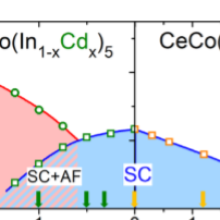Investigate the hybridization gap near the quantum critical point!
- Heavy fermion system has competing Kondo effect and RKKY interaction
- Transition between Kondo and RKKY goes to 0 K, Quantum fluctuation occurs, Quantum critical point (QCP)
- The superconductivity observed in some heavy fermion with TcMax located at QCP
- Infrared spectroscopy can reveal the electronic structure, thus gives insight into the underlying mechanism
Collaboration of Kondo effect and Ruderman-Kittel-Kasuya-Yosida (RKKY) interaction gives rise to the quantum fluctuation in heavy fermion systems. The Kondo effect is a spin-flip scattering by the local magnetic moments, whereas the RKKY interaction is a type of double-exchange interaction of magnetic moments mediated by the conduction electrons. These two phenomena compete each other and depending on the coupling strength, a second order transition occurs. When this transition goes to zero temperature (quantum critical point), the quantum fluctuation takes place providing fertile physics including superconductivity and non-Fermi liquid behavior. The goal of this project is to understand the electronic structure of heavy fermion systems near this quantum critical point. As a model system, CeMIn5 (M = Co, Ir and Rh) will be examined via infrared spectroscopy. By substituting the M, different phases can be achieved, thus a systematic spectroscopic investigation will provide an insight into the detailed electronic structures and their behavior under different condition.

Seulki Roh
Dr.Infrared spectroscopy




